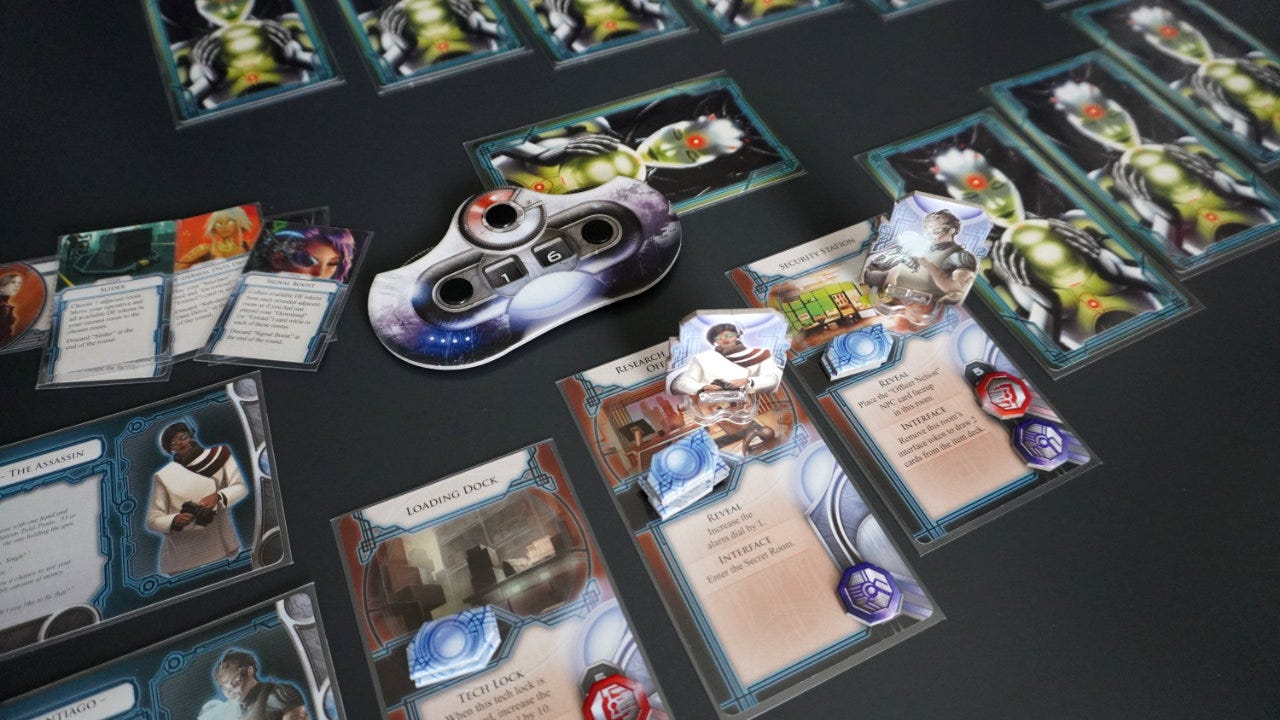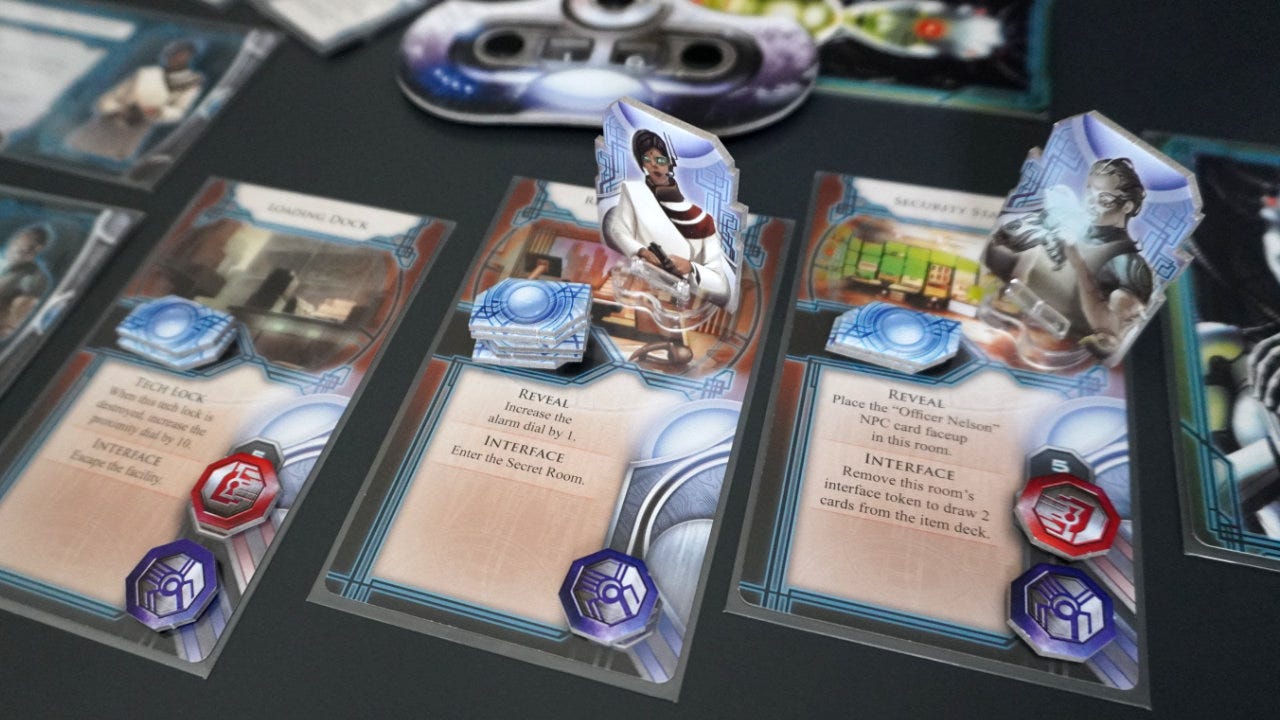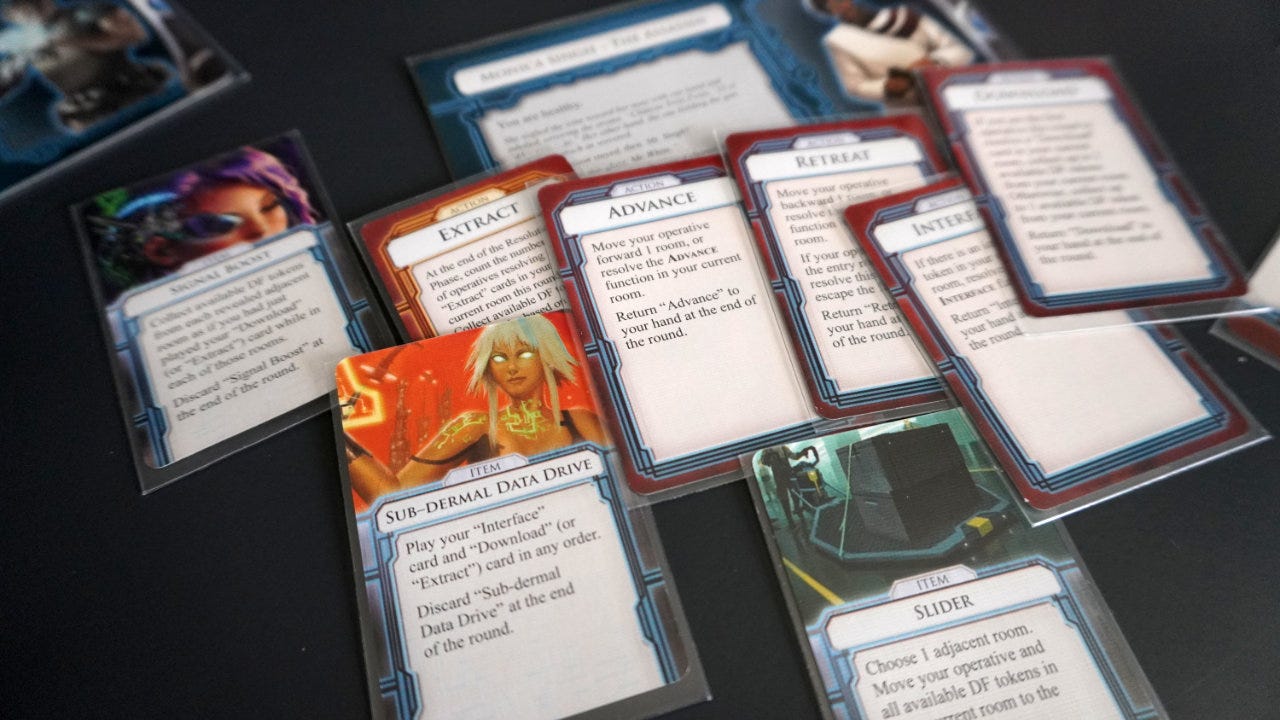Steal some zettabytes and everyone loses
Exploring push your luck mechanisms and games where everyone loses with Android: Infiltration, a cyberpunk tech heist game from Fantasy Flight Games
Welcome to Skeleton Code Machine, an ENNIE-nominated and award-winning weekly publication that explores tabletop game mechanisms. Check out Public Domain Art and Fragile Games to get started. Subscribe to TUMULUS to get more design inspiration delivered to your door each quarter!
Last week we looked at ten lessons from five games that I recently played. This week, we are exploring one of the games I played that weekend but didn’t mention: Android: Infiltration.
Android: Infiltration
Android: Infiltration (2012) was designed by Donald X. Vaccarino of Dominion (2008) fame and published by Fantasy Flight Games (FFG). It is set in FFG’s Android universe, the same cyberpunk world used for the beloved but now dead Android: Netrunner LCG.1 In fact, almost all of the art assets used in the game are reused from Android: Netrunner cards.
Each player takes on the role of a hacker (i.e. “operative”) breaking into CyberSolutions Inc. to steal digital files. Files are available in the 13 room cards that are placed face down as part of the game’s setup. When a room is revealed it will usually have a number of data files (DF) available, each worth 1, 2, or 3 victory points (i.e. “zettabytes”) at the end of the game.
Players use a simultaneous action selection mechanism to choose an action each round: advance, retreat, interface, download, or extract. There are also item cards available which add actions and allow players to interact with lab workers, tech locks, and interfaces in the rooms.
Room are arranged in a single line or path through the building, starting with the first floor and then to the second floor. Second floor rooms generally have more DF to steal and a better chance of finding loot.
The trick is that the farther players advance into the building, the farther they need to retreat back out. All the while, the alarm level is increasing and corporate security mercs are getting closer.
Fail to get out out of the building before they arrive and your DF are worth nothing.
The Security Tracker
The game uses a security tracker with two dials:
Proximity dial (0 - 99): Tracks the progress of the security mercs’ advancement. When this dial hits 99, each operative still in the building is captured and ends the game with zero points.
Alarm dial (-1 - 8): Tracks the number of alarms the players have triggered inside the facility. This value is added to the die roll during each security phase.
The proximity dial starts at 0. At the end of each round a six-sided die (d6) is rolled and the alarm dial value is added to the result. This combined total is added to the proximity dial, causing the security force to get ever closer. The higher the alarm, the faster they will arrive.
With an average roll of 3, it might seem like there is a lot of time before the proximity reaches 99 and the game ends. The increasing alarm value drastically shortens this however. Before long the proximity is increasing by 10 - 12 each time.
That unknown duration is the source of the inherent tension and tough decisions in Android: Infiltration. How far do you push into the facility before you turn around to head out? Do you have time for one more room? Is it worth taking another turn to download some more data files?
Remember, all the DF you have are worth nothing if you don’t make it out before the proximity dial hits 99.
Everyone loses the game
Android: Infiltration is a competitive, not cooperative, game so each hacker is trying to steal more than the others and hinder them when possible. It’s a game with a lot of theme, but also a considerable amount of randomness. For example, items are powerful but you might just never happen to find the one you needed.
The interesting part is that it is quite likely that everyone will lose the game. If everyone works against each other, it is possible to slow the escape of all players. The proximity alarm keeps increasing, and if no one makes it out… everyone loses.
Having all players lose is common (if not required) in modern co-op board games, but it is less common in competitive games. Usually someone will win, even if they only scored a few points.
Thematically, I think this makes sense for Android: Infiltration. After all, getting gunned down by corp sec with a pile of stolen data files in your rig doesn’t seem like a good victory condition.
Conclusion
Some things to think about:
How far do you push: Android: Infiltration is one of my favorite examples of having the player decide how far to push into an area, zone, or dungeon before they decide it’s time to get the heck out of there. The Clank! (2016) series of games is another good example. Both were inspirations for me when designing Exclusion Zone Botanist.2
Everyone loses: While most competitive tabletop games will choose a single winner when the end game is triggered, this isn’t always the case. Android: Infiltration demonstrates that it is possible for everyone to lose. Nemesis (2018) is a more recent example of this in board games.3
A universe of games: I love the FFG Android universe and appreciated their attempt to make a broad range of games all with the same setting: Android: Netrunner (2012), Android: Infiltration (2012), New Angeles (2016), and Android: Mainframe (2016). They weren’t all great games, but I appreciate the concept.
What do you think? How do you feel about games where it is possible for all players to lose? Should games always have a winner?
— E.P. 💀
P.S. I’m working on a new SCM guide called ADVENTURE! Make Your Own TTRPG Adventure. Pre-orders will be opening soon. Follow Exeunt Press on Bluesky to see some WIP screenshots and details.
Skeleton Code Machine is a production of Exeunt Press. All previous posts are in the Archive on the web. Subscribe to TUMULUS to get more design inspiration. If you want to see what else is happening at Exeunt Press, check out the Exeunt Omnes newsletter.
While the official publication of Android: Netrunner is dead, the game lives on. Nullsignal Games is still publishing compatible cards and running tournaments. You can also play online at jinkteki.net.
I’m launching Exclusion Zone Botanist: Epsilon on Kickstarter in Spring 2025. Follow the pre-launch page to be notified when it goes it live.
Check out the article on semi-cooperative games for more on Nemesis. This article was one of the “best of” articles printed in the first issue of Tumulus.









I personally have never played a competitive game where everybody loses. The concept sounds really interesting to me. Maybe sometimes it's worth it to sabotage to try to get the group to loose.
This mechanic made me also think about designs where everybody "could" win. Games like that could be interesting as well but sadly I haven't played any like that.
I think "everybody loses" is very hard to pull of in a competitive game.
From the game theory point of view, the outcome for players are as following, from most to least desired:
1. I win.
2. Everybody "loses", including me, so it's effectively a draw.
3. Somebody else wins, I lose.
This leads to the logic: "If I'm not winning, then it's better for me to force a draw rather than play to win". If there are more than two players, now you have a team that plays _for_ the game _against_ the single winning player.
This happened with our group in CO2: after we've identified the leader, everybody started to kill ecology like crazy, because avoiding loss is now leader's problem. I haven't played Infiltration though, it might be not a problem if players can't trigger more alarms on purpose, or if the leader is obscured.
I find thematical explanations such as "ah but your character dies if everybody loses, while you survive if somebody wins" or "but you destroy the ecology" very fragile. If we would play based on theme, rather than rules, then it would make sense to yield in chess to save your pawn's lives. Mechanically though, communal loss conditions can quickly wreck the game.